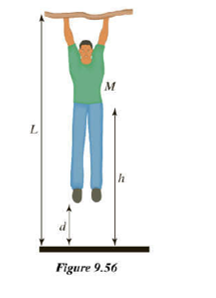You hang by your hands from a tree limb that is a heightabove the ground, with your center of mass a heightabove the ground and your feet a heightabove the ground, as shown in Figure 9.56. You then let yourself fall. You absorb the shock by bending your knees, ending up momentarily at rest in a crouched position with your center of mass a heightabove the ground. Your mass is M. You will need to draw labeled physics diagrams for the various stages in the process.

(a) What is the net internal energy change in your body (chemical plus thermal)? (b) What is your speed vat the instant your feet first touch the ground? (c) What is the approximate average force Fexerted by the ground on your feet when your knees are bending? (d) How much work is done by this force,F?



